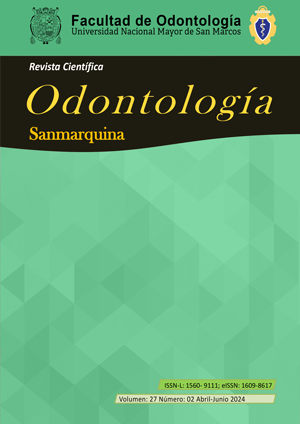Mesialización del sector posterior por la ausencia del primer molar mediante el uso de microimplantes
DOI:
https://doi.org/10.15381/os.v27i2.27301Palabras clave:
Mesialización de molares, ausencia dental, microimplantesResumen
Se presenta un caso clínico de paciente femenina de 16 años, la cual reportó haber perdido su primer molar superior izquierdo por caries dos años atrás. Es una paciente con maloclusión clase II esquelética, mesofacial, perfil recto, clase I molar derecho, ausencia del diente 26, clase I canina derecha y tendencia a clase II canina izquierda, con apiñamiento leve superior e inferior y línea media dental inferior desviada a la izquierda. Se trató mediante el uso de microimplante, con el objetivo de mesializar los dientes 27 y 28 así como mejorar el asentamiento de la clase canina izquierda. Se finalizó de manera exitosa la mesialización de los dientes posteriores superiores izquierdos, estableciendo una adecuada oclusión, eliminando el apiñamiento, logrando una buena guía anterior con líneas medias dentales coincidentes, proporcionando una sonrisa funcional y armoniosa. El propósito de este caso es demostrar que con las herramientas y mecánicas adecuadas además de una buena planificación, se puede lograr el control del anclaje en el movimiento de cierre posterior a falta de un molar ausente, y así lograr establecer una adecuada oclusión.
Descargas
Referencias
Hatami A, Dreyer C. The extraction of first, second or third permanent molar teeth and its effect on the dentofacial complex. Aust Dent J. 2019;64(4):302-311. DOI: https://doi.org/10.1111/adj.12716
Demir P, Aydoğdu H. Ideal spontaneous space closure after late extraction of permanent first molar teeth. Cumhuriyet Dent J. 2020;23(4):331–9. DOI: https://doi.org/10.7126/cumudj.793013
Ratanasereeprasert N, Weng CY, Yang SYH, Chen YJ, Yao CCJ. Molar space closure: To do or not to do?. APOS Trends Orthod 2022;12:61-8. DOI: https://doi.org/10.25259/APOS_112_2021
Cardoso PC, Mecenas P, Normando D. The impact of the loss of first permanent molars on the duration of treatment in patients treated with orthodontic space closure and without skeletal anchorage. Prog Orthod. 2022;23(1):32. DOI: https://doi.org/10.1186/s40510-022-00427-2
Thiesen G, Gribel BF, Pereira KC, Freitas MP. Is there an association between skeletal asymmetry and tooth absence? Dental Press J Orthod. 2016;21(4):73-79. DOI: https://doi.org/10.1590/2177-6709.21.4.073-079.oar
Schubert A, Jäger F, Maltha JC, Bartzela TN. Age effect on orthodontic tooth movement rate and the composition of gingival crevicular fluid. J Orofac Orthop. 2020;81(2):113-25. DOI: https://doi.org/10.1007/s00056-019-00206-5
Baik UB. Molar protraction: Orthodontic substitution of missing posterior teeth. In: Kim KB, editor. Temporary Skeletal Anchorage Devices: A Guide to Design and Evidence-Based Solution. Berlin, Heidelberg: Springer; 2014. p. 119-60. DOI: https://doi.org/10.1007/978-3-642-55052-2_8
Baik UB, Sugawara J, Chun YS, Mandair S, Park JH. Envisioning post-treatment occlusions after space closure using temporary skeletal anchorage devices. J Clin Pediatr Dent. 2019;43(2):131–6. DOI: https://doi.org/10.17796/1053-4625-43.2.11
Baik UB, Chun YS, Jung MH, Sugawara J. Protraction of mandibular second and third molars into missing rst molar spaces for a patient with an anterior open bite and anterior spacing. Am J Orthod Dentofacial Orthop. Am J Orthod Dentofacial Orthop. 2012;141(6):783-795. DOI: https://doi.org/10.1016/j.ajodo.2010.07.031
Naoum S, Allan Z, Yeap CK, Razza JM, Murray K, Turlach B, et al.Trends in orthodontic management strategies for patients with congenitally missing lateral incisors and premolars. Angle Orthod. 2021;91(4):477-483. DOI: https://doi.org/10.2319/092320-809.1
Palone M, Casella S, de Sbrocchi A, Siciliani G, Lombardo L. Space closure by miniscrew-assisted mesialization of an upper third molar and partial vestibular fixed appliance: A case report. Int Orthod. 2022;20(1):106002. DOI: https://doi.org/10.1016/j.ortho.2021.100602
Johns G. Orthodontics mini implants – A brief review. Int Dent J Stud Res. 2021;9(4):176–180. DOI: https://doi.org/10.18231/j.idjsr.2021.033
Negi N, Sharma D, Chandel M, Jhingta P. Microimplant assisted extraction space closure: Biomechanical considerations. J Dent Implants. 2015;5(1):87-89. DOI: https://doi.org/10.4103/0974-6781.154457
Marusamy KO, Ramasamy S, Wali O. Molar protraction using miniscrews (temporary anchorage device) with simultaneous correction of lateral crossbite: An orthodontic case report. J Int Soc Prev Community Dent. 2018;8(3):271–276. DOI: https://doi.org/10.4103/jispcd.JISPCD_447_17
Bhagat A, Goel M, Batra P, Chugh RK. Mandibular molar protraction with orthodontic temporary anchorage devices: A case report. Indian J Clin Pract. 2014;25(4):338-341.
Nagaraj K, Upadhyay M, Yadav S. Titanium screw anchorage for protraction of mandibular second molars into first molar extraction sites. Am J Orthod Dentofacial Orthop. 2008;134(4):583-591. DOI: https://doi.org/10.1016/j.ajodo.2006.09.055
Roberts WE, Nelson CL, Goodacre CJ. Rigid implant anchorage to close a mandibular First molar extraction site. J Clin Orthod. 1994;28(2):693-704
Teo T, Ashley P, Parekh S, Noar J. The evaluation of spontaneous space closure after the extraction of first permanent molars. Eur Arch Paediatr Dent. 2013;14(4):207–212. DOI: https://doi.org/10.1007/s40368-013-0042-7
Baik UB, Kook YA, Bayome M, Park JU, Park JH. Vertical eruption patterns of impacted mandibular third molars after the mesialization of second molars using miniscrews. Angle Orthod. 2016;86(4):565-570. DOI: https://doi.org/10.2319/061415-399.1
Descargas
Publicado
Número
Sección
Licencia
Derechos de autor 2024 Matilde Valeria Pérez-Landeros, Cesar Fernando Gonzalez-Ochoa, Jacqueline Adelina Rodríguez-Chávez, José Luis Meléndez-Ruiz, Celia Guerrero-Velázquez

Esta obra está bajo una licencia internacional Creative Commons Atribución 4.0.
LOS AUTORES RETIENEN SUS DERECHOS:
a. Los autores retienen sus derechos de marca y patente, y también sobre cualquier proceso o procedimiento descrito en el artículo.
b. Los autores retienen el derecho de compartir, copiar, distribuir, ejecutar y comunicar públicamente el artículo publicado en la Odontología Sanmarquina (por ejemplo, colocarlo en un repositorio institucional o publicarlo en un libro), con un reconocimiento de su publicación inicial en la revista Odontología Sanmarquina.
c. Los autores retienen el derecho a hacer una posterior publicación de su trabajo, de utilizar el artículo o cualquier parte de aquel (por ejemplo: una compilación de sus trabajos, notas para conferencias, tesis, o para un libro), siempre que indiquen la fuente de publicación (autores del trabajo, revista, volumen, número y fecha).




















